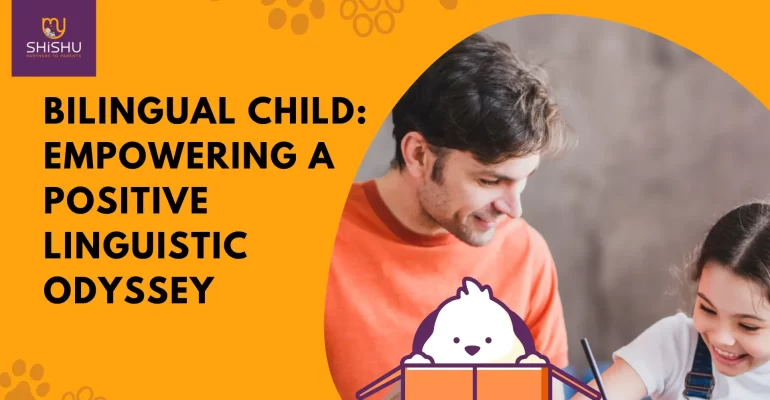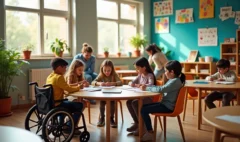Bilingual Child: Empowering a Positive Linguistic Odyssey
Bilingual Child: Empowering a Positive Linguistic Odyssey
Introduction
In the rich tapestry of childhood development, the term “bilingual child” stands as a beacon of cognitive prowess and cultural richness. As parents, the decision to nurture bilingualism in our children is a deliberate choice to bestow upon them the lifelong gift of linguistic versatility. In this comprehensive guide, we embark on a journey into the fascinating realm of raising a bilingual child. Beyond the surface of fluency in two languages, we explore the cognitive advantages, delve into effective strategies, and navigate the challenges that weave into the fabric of this linguistic tapestry.
What is bilingualism?
Bilingualism is more than mastering two languages—it’s a cognitive symphony enriching a child’s mind. Beyond the words spoken, it shapes superior problem-solving skills, introduces cultural diversity, and enhances social adaptability. Bilingualism is a dynamic fusion of cognitive, cultural, and social dimensions, laying the foundation for a unique and enriched upbringing.
The Bountiful Benefits of Bilingualism Child
Embarking on the journey of raising a bilingual child promises a host of cognitive, academic, and cultural advantages. Understanding these benefits is crucial for parents committed to providing their children with the gift of bilingualism.
- Cognitive Advantages: Bilingual children exhibit enhanced cognitive flexibility, a skill crucial for navigating complex problem-solving tasks. The constant toggling between languages develops a cognitive agility that extends beyond linguistic realms, influencing memory, attention, and creative thinking.
- Academic Prowess: Numerous studies highlight that bilingualism correlates with academic success. Bilingual children often outperform their monolingual peers in tasks requiring critical thinking, reading comprehension, and mathematical reasoning.
- Cultural Enrichment: Bilingualism is a gateway to diverse cultures. It fosters an appreciation for different customs, traditions, and perspectives, nurturing a global mindset in the growing child.
- Improved Executive Function: The ability to seamlessly switch between languages hones executive functions such as problem-solving, task-switching, and multitasking. Bilingual children develop a heightened awareness of their surroundings and an increased capacity for managing complex cognitive processes.
- Delayed Onset of Dementia: Studies suggest that bilingualism may contribute to delaying the onset of dementia in later life. The constant mental exercise involved in managing two languages appears to have a protective effect on the brain.
- Enhanced Communication Skills: Bilingual children are adept communicators. Their exposure to varied linguistic structures sharpens their communication skills, making them effective and nuanced communicators in both written and spoken forms.
Understanding the myriad benefits of bilingualism empowers parents to appreciate the profound impact it can have on their child’s overall development. From cognitive advantages to academic excellence and cultural appreciation, the journey of bilingualism is a gateway to a brighter and more enriched future.
Navigating Bilingual Waters: Key Considerations for Parents
Raising bilingual children is a rewarding yet nuanced journey that requires thoughtful navigation. Here, we explore the pivotal considerations for parents committed to fostering linguistic diversity within their family.
- Choose Your Approach Wisely: Opt for a language strategy that aligns with your family dynamics. Whether employing the One Parent, One Language (OPOL) method or embracing Minority Language at Home (ML@H), a deliberate approach ensures consistency and clarity in language exposure.
- Start Early, Stay Consistent: The early years are a linguistic sponge, and consistency is the key. Introduce both languages early on and maintain a consistent language environment to facilitate natural language acquisition.
- Embrace code-switching as normal. Code-switching, the fluid transition between languages within a conversation, is a natural aspect of bilingualism. Embrace it as a sign of linguistic agility rather than viewing it as confusion.
- Tailor Language Exposure to Contexts: Adapt language exposure based on the context. For example, designate specific times for each language, ensuring that the child understands the social and cultural contexts in which each language thrives.
- Be Prepared for Varied Language Proficiency: It’s common for bilingual children to exhibit different levels of proficiency in each language. Celebrate progress in both languages and provide additional support where needed.
- Foster a Language-Positive Environment: Create a positive attitude towards both languages by incorporating language into daily routines, celebrating language achievements, and engaging in language-rich activities.
- Be Mindful of Societal Pressures: External pressures and societal attitudes towards bilingualism may vary. Be prepared to address misconceptions and educate others about the cognitive and cultural benefits of raising bilingual children.
- Seek support from bilingual communities. Connect with other bilingual families or communities for support and shared experiences. Networking with like-minded parents provides valuable insights and a sense of community.
By considering these key factors, parents can navigate the intricate path of raising bilingual children with confidence, creating an environment where language flourishes naturally and becomes an integral part of the child’s identity.
Nurturing bilingual brilliance opens doors to cultural richness, cognitive agility, and a world of limitless possibilities for our children.
Monolingual vs. Bilingual: A Brief Comparison
Monolingual: Monolingualism involves fluency in a single language. While convenient, it may limit the cognitive benefits and cultural exposure associated with bilingualism.
Bilingual: Bilingualism, the mastery of two languages, opens doors to cognitive advantages, enhanced communication skills, and cultural enrichment. Bilingual individuals navigate a diverse world with ease, fostering a global mindset and an appreciation for linguistic diversity.
Choosing between monolingualism and bilingualism is a decision with far-reaching implications, influencing a child’s cognitive development, cultural awareness, and adaptability in an interconnected world.
Deciding a Language: A Thoughtful Choice
Selecting the languages for your bilingual journey is a pivotal decision. Consider factors such as family heritage, cultural ties, and practicality. Opt for languages that hold personal significance, ensuring a meaningful connection for both you and your child. Strive for a balance that aligns with your family’s values and goals. A thoughtful language choice lays the foundation for a rich linguistic and cultural upbringing.
Crafting Your Bilingual Strategy: A Strategic Approach
Tailor your bilingual strategy to fit your family dynamics and goals. Whether adopting the One Parent, One Language (OPOL) method, where each parent speaks a different language, or embracing Minority Language at Home (ML@H), consistency is key. Establish dedicated times for each language, create language-rich environments, and celebrate milestones. Flexibility is crucial; adjust your strategy as your child’s language proficiency evolves. By customizing your approach and staying committed to fostering bilingualism, you set the stage for a successful and enriching linguistic journey.
Crafting Your Bilingual Plan: A Blueprint for Success
Creating a comprehensive plan for raising a bilingual child is the cornerstone of a successful linguistic journey. Follow these steps to develop a tailored strategy that aligns with your family’s vision:
- Define Your Language Goals: Clearly outline your objectives, whether they involve cultural preservation, cognitive development, or broader communication skills.
- Choose Your Approach: Select a language methodology that suits your family, be it OPOL, ML@H, or a combination. Ensure it aligns with your lifestyle and values.
- Set Consistent Language Exposure: Establish dedicated times for each language, fostering a consistent language-rich environment.
- Introduce Cultural Elements: Infuse cultural aspects into language exposure, providing a holistic experience for your child.
- Adapt as Needed: Stay flexible and adapt your plan based on your child’s language development and changing family dynamics.
- Celebrate Language Milestones: Acknowledge and celebrate language achievements, reinforcing a positive attitude towards bilingualism.
By crafting a personalized bilingual plan, you pave the way for a seamless and enriching linguistic journey, ensuring your child flourishes in a multilingual and multicultural world.
Professional Support: Navigating Bilingual Challenges
Seeking professional guidance is a prudent step in your bilingual journey. Consult pediatricians, speech therapists, or educators experienced in language development to address any concerns. Speech therapists can offer insights into language delays, while educators can tailor learning approaches. Collaborating with professionals ensures a comprehensive approach to your child’s bilingual development, providing valuable support in navigating potential challenges and fostering a positive linguistic environment.
Start Young: Planting the Seeds of Bilingualism
Commencing the bilingual journey early is paramount. Young minds absorb languages effortlessly, making infancy and toddlerhood ideal periods for introduction. Engage in playful interactions, read bilingual books, and incorporate language into daily routines. Starting young lays a robust foundation, allowing your child to naturally embrace the richness of dual languages. Early exposure sets the stage for a lifelong affinity for bilingualism, enhancing cognitive abilities, and fostering cultural appreciation.
Navigating Pitfalls: Common Mistakes in Bilingual Upbringing
While the journey of raising a bilingual child is rewarding, it’s not without its challenges. Avoid these common pitfalls:
- Inconsistent Language Exposure: Fluctuating language exposure confuses a child. Consistency is key to effective language acquisition.
- Neglecting Cultural Context: Focusing solely on language overlooks the cultural nuances essential for a holistic bilingual upbringing.
- Ignoring Individual Proficiency: Each child may excel in one language over the other. Addressing disparities ensures balanced language development.
- Succumbing to External Pressures: Societal misconceptions may influence decisions. Stay true to your bilingual goals, educating others about its cognitive and cultural benefits.
Navigating these common mistakes equips parents for a smoother bilingual journey, fostering a rich linguistic and cultural environment for their child.
Busting Bilingual Myths: Separating Fact from Fiction
In the realm of bilingual upbringing, several myths persist, clouding the understanding of this enriching journey. Let’s debunk these misconceptions:
- Myth: Bilingualism Causes Confusion; Fact: Bilingual children naturally navigate between languages, demonstrating cognitive flexibility without confusion.
- Myth: Bilingual Children Lag in Academic Performance: Fact: Research indicates bilingual children often outperform monolingual peers in critical thinking and academic achievements.
- Myth: It’s Too Late to Start Bilingualism: Fact: Starting at any age yields cognitive benefits; early exposure is advantageous but not a prerequisite for success.
Unraveling these myths empowers parents to embrace bilingualism confidently, recognizing its myriad cognitive, cultural, and academic advantages.
FAQs Related to Bilingual Child Development
-
Why should I raise my child to be bilingual?
Bilingualism offers cognitive benefits, improved academic performance, and enhanced cultural understanding, providing your child with a valuable skill set for the future.
-
Which language method is more effective—OPOL or ML@H?
Both One Parent, One Language (OPOL) and Minority Language at Home (ML@H) can be effective. Choose the method that aligns with your family’s dynamics and ensures consistent exposure to both languages.
-
Will raising a bilingual child cause language confusion?
No, research shows that bilingual children can differentiate between languages and exhibit cognitive advantages without confusion.
-
How can I support my child’s language development at home?
Create a language-rich environment, incorporate bilingual books and activities, and encourage consistent communication in both languages.
-
Are there potential language development challenges?
While some children may experience temporary language mixing or delays, consistent exposure and support can address these challenges, leading to successful bilingual development.
Conclusion
In unraveling the complexities of raising bilingual children, we discover it’s both an art and a science. Beyond mastering two languages, it’s about cultivating cognitive agility, celebrating diverse cultures, and fostering a global mindset. Crafting a thoughtful plan, starting early, and dispelling common myths are essential steps. This journey is a gift—a rich tapestry of language, culture, and cognitive benefits. As you navigate challenges and celebrate milestones, remember that you’re investing in a future-ready individual. May your bilingual adventure be filled with joy and discovery, nurturing confident, culturally aware, and globally minded children. Here’s to cultivating bilingual brilliance—a lifelong gift that transcends language and shapes the next generation.











